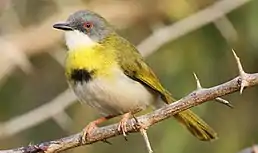Нікорник
Ніко́рник[1] (Apalis) — рід горобцеподібних птахів родини тамікових (Cisticolidae). Представники цього роду мешкають в Африці на південь від Сахари
? Нікорник | ||||||||||||||
|---|---|---|---|---|---|---|---|---|---|---|---|---|---|---|
 Нікорник жовтоволий (Apalis flavida) | ||||||||||||||
| Біологічна класифікація | ||||||||||||||
| ||||||||||||||
Види | ||||||||||||||
| ||||||||||||||
Посилання | ||||||||||||||
| ||||||||||||||
Опис
Нікорники — дрібні птахи з відносно довгими хвостами і тонкими дзьобами, пристосованими до полювання на комах. Середня довжина тіла представників роду становить 11-14 см, середня вага — 6-15 г. Верхня частина тіла нікорників зазвичай коричнева, сіра або зелена, а у деяких видів нижня частина тіла є яскравою. Самці і самички часто є подібними, однак у деяких видів самці, на відміну від самичкок мають яскраве забарвлення[2].
Нікорники живуть в лісах і чагарникових заростях.
Таксономія і систематика
Рід був введений британським орнітологом Вільямом Джоном Свенсоном в 1833 році[3]. Типовим видом є нікорник смуговолий (Apalis thoracica)[4]. Раніше рід Нікорник відносили до родини кропив'янкових (Sylviidae), однак нині його, разом з низкою інших родів відносять до родини тамікових (Cisticolidae)[5].
За резульатами молекулярно-генетичного дослідження кілька видів, яких раніше відносили до роду Нікорник буди переведикі до родів Африканський кравчик (Artisornis) та Oreolais[6][7].
Види
Виділяють двадцять чотири види:[8]
- Нікорник смуговолий, Apalis thoracica
- Нікорник жовтогорлий, Apalis flavigularis
- Нікорник таїтянський, Apalis fuscigularis
- Нікорник нумалійський, Apalis lynesi
- Нікорник білобровий, Apalis ruddi
- Apalis flavocincta[9]
- Нікорник жовтоволий, Apalis flavida
- Нікорник вусатий, Apalis binotata
- Нікорник чорнощокий, Apalis personata
- Нікорник біловусий, Apalis jacksoni
- Нікорник білокрилий, Apalis chariessa
- Нікорник сьєрра-леонський, Apalis nigriceps
- Нікорник чорноголовий, Apalis melanocephala
- Нікорник попелястий, Apalis chirindensis
- Нікорник рудогорлий, Apalis porphyrolaema
- Нікорник кабобський, Apalis kaboboensis
- Нікорник гірський, Apalis chapini
- Нікорник чорний, Apalis sharpii
- Нікорник білочеревий, Apalis rufogularis
- Нікорник сріблистий, Apalis argentea
- Нікорник угандійський, Apalis karamojae[10]
- Нікорник камерунський, Apalis bamendae
- Нікорник заїрський, Apalis goslingi
- Нікорник сірий, Apalis cinerea
- Нікорник буроголовий, Apalis alticola
Примітки
- Фесенко Г. В. Вітчизняна номенклатура птахів світу. — Кривий Ріг : ДІОНАТ, 2018. — 580 с. — ISBN 978-617-7553-34-1.
- Sinclair, Ian; Ryan, Peter (2003). Birds of Africa south of the Sahara. Struik. с. 512, 540. ISBN 1-86872-857-9.
- Swainson, William John (1833). Zoological Illustrations, or original figures and descriptions of new, rare, or interesting Animals, selected chiefly from the classes of ornithology, entomology, and conchology and arranged according to their apparent affinities. Series 2. Volume 3. London: Baldwin and Cradock. Plate 119 text.
- Mayr, Ernst; Cottrell, G. William, ред. (1986). Check-list of Birds of the World. Volume 11. Cambridge, Massachusetts: Museum of Comparative Zoology. с. 154.
- Roberson, Don. Cisticolas & Allies Cisticolidae. Архів оригіналу за 21 квітня 2007. Процитовано 29 березня 2007.
- Nguembock, B; Fjeldså, J.; Tillier, A.; Pasquet, E. (2007). A phylogeny for the Cisticolidae (Aves: Passeriformes) based on nuclear and mitochondrial DNA sequence data, and a re-interpretation of an unique nest-building specialization. Molecular Phylogenetics and Evolution 42 (1): 272–286. PMID 16949311. doi:10.1016/j.ympev.2006.07.008.
- Nguembock, B.; Fjeldså, J.; Couloux, A.; Cruaud, C.; Pasquet, E. (2008). Polyphyly of the genus Apalis and a new generic name for the species pulchra and ruwenzorii. Ibis 150 (4): 756–765. doi:10.1111/j.1474-919X.2008.00852.x.
- Gill, Frank; Donsker, David, ред. (2021). Grassbirds, Donacobius, Malagasy warblers, cisticolas & allies. World Bird List Version 7.3. International Ornithologists' Union. Процитовано 15 серпня 2021.
- Species Updates – IOC World Bird List (амер.). Процитовано 18 червня 2021.
- Shaw, Philip; Mungaya, Elias (2006). The status and habitat of Karamoja Apalis Apalis karamojae in the Wembere Steppe, Sukumaland, Tanzania. Bird Conservation International 16 (2): 97–111. doi:10.1017/S0959270906000049.
- Jobling, James A. (2010). The Helm Dictionary of Scientific Bird Names. London: Christopher Helm. с. 50. ISBN 978-1-4081-2501-4.
Джерела
- Ryan, Peter (2006). Family Cisticolidae (Cisticolas and allies). У del Hoyo J., Elliott A.; Christie D.A. Handbook of the Birds of the World. 11. Old World Flycatchers to Old World Warblers. Barcelona: Lynx Edicions. с. 378–492. ISBN 978-84-96553-06-4.